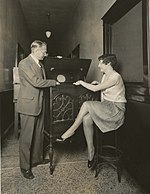In the early stages Television used a combination of optical, electronic even mechanical technology to capture transmit and display a visual image. By the late 1920's there was a race between John logie bairds mechanical scanning, and EMI's electronic scanning. EMI employed Alan Dower Blumlien to use a method of scanning the picture one line at a time from left to right faster then the eye could process.
This wasn't a new concept as early fax machines used this method of scanning line by line to build up a full image.
on August 22 1932 BBc launched its own regular service using Bairds 30 line electromechanical system.
It continued until september 1935. By November 1936 the BBC began broadcasting a dual system service, alternating service. Between Marconi EM's 405 line standard and Bairds improved 240 line standard, from Alexandra Palace in London. Making the British Broadcasting Corporation Television service the worlds first regular High definitions television service.
The government , on the advice of the the special advisory committee choose Marconi- EMI's electronic system gave a superior picture. Bairds system was dropped in February 1937. TV broadcasts in London were on the air an average 4 hours a day from 1936 to 1939, which means a average number of 12,000 15000 viewers. Most TV sets were in bars and restaurants so that they can attract a large crowd for sporting events.
The outbreak of the second world war caused the BBC service to be abruptly suspend on september 1939.
This was because the TV transmission could be used as a homing beacon to guide enemy aircraft to London.
It resumed again from Alexandra Palace on June 7 1946 after the end of the war,
By 1947 there were 54,000 licensed television receivers, compared with 44,000 sets in the US at the time.
I thought about the future of viewing and watching your shows. But there are several avenues that TV can travel down. For me I like that TV can perhaps provide a reality we can think thats believable. The early pioneering work by John Logie Baird and EMI research and development team, paved way to the golden era of television. Now I can see a new era of interactive viewing with the internet and mobile streaming. Television or the old idea of programed viewing seems to be changing with the idea or record now play back later. This change has brought about convenience and yet a sudden coldness to its content. No longer do we shape our lives to fit the programmed times but we now look for only the best shows.
This idea of watching the best shows and TV ratings wars has brought about a subtle change in our attention span. I like to think we are changing when we add on bits of technology in our lives, and its these changes that make me wonder if we are improving or evolving around the things we make. I can only predict the key to our future maybe in the way we as a society spend our waking lives. Television did have a big part of our lives but I think content and information becomes a growing concern. I once wrote a paper on how audio visual stimulus would help to accelerate learning process. I still think that matters today, if we can edit our interest for positive shows or information that enriches our lives.
There is a saying that "you are what you eat" and if we continue to feed on (watching bad shows) see negative images, our apathy will continue to grow. Television is a one way system and you see what they want you to see. The internet allows people to react and possibly take part perhaps in a positive way. I wanted to write a history of television to find its path to the future. Instead I found it to be a evolving technology that has peaked in popularity. Now filtering down to our smart phones and Tablets, fighting our attention along with E-books and social networks and games.




No comments:
Post a Comment